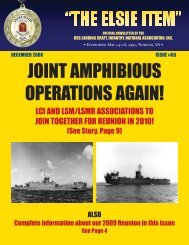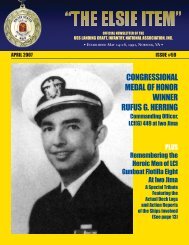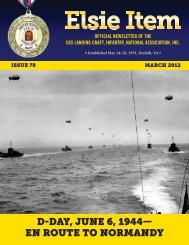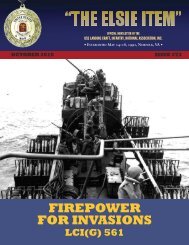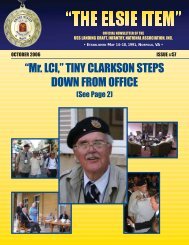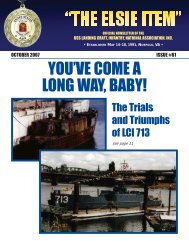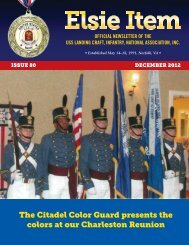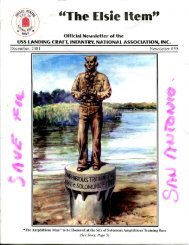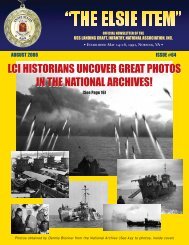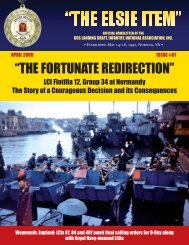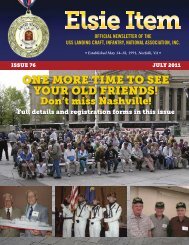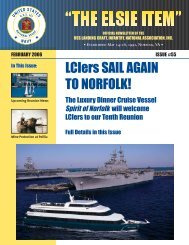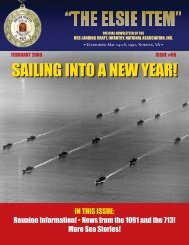âOh GOd, yOur sea is sO larGe and my ship is sO smallâ
âOh GOd, yOur sea is sO larGe and my ship is sO smallâ
âOh GOd, yOur sea is sO larGe and my ship is sO smallâ
You also want an ePaper? Increase the reach of your titles
YUMPU automatically turns print PDFs into web optimized ePapers that Google loves.
The lasT lCiA son d<strong>is</strong>covers h<strong>is</strong> father’scomm<strong>and</strong> in the Pacific WarBy Henry AllenHenry Allen <strong>is</strong> the son of the Henry Allen who skippered the 1091from Bay City, MI through the battle of Okinawa <strong>and</strong> then toJapan. He <strong>is</strong> a Pulitzer Prize-winning journal<strong>is</strong>t while writing forThe Washington Post. After he retired he wrote the h<strong>is</strong>tory of h<strong>is</strong>d<strong>is</strong>covery of the 1091 for a magazine called Military H<strong>is</strong>tory.In submitting th<strong>is</strong> story to us, Henry remarked “How proud hewould be to know that the 1091 <strong>is</strong> the flag<strong>ship</strong> of the LCIassociation!”William Faulkner wrote a lot of things worthy of the NobelPrize. One of them was th<strong>is</strong>: “The past <strong>is</strong> never dead. It’snot even past.” Call it Faulkner’s Law, <strong>and</strong> here <strong>is</strong> how I learnedthe truth of it.My father, Lieutenant Henry S. Allen Jr., comm<strong>and</strong>ed a <strong>ship</strong> inWorld War II, LCI(L)-1091.It wasn’t a big <strong>ship</strong>—158 feet long—but it was h<strong>is</strong> <strong>ship</strong>, <strong>and</strong> hewas <strong>my</strong> father, so it loomed huge in <strong>my</strong> boyhood imagination, alegend, a <strong>my</strong>th. I am 68 now, <strong>and</strong> it still looms.A photograph of 1091 hangs on a wall in <strong>my</strong> studio, a gray<strong>and</strong> dirty combat <strong>ship</strong>, forging against a bow wave, lookingsomehow tired on a cloudy day when the kamikazes weren’tattacking at Okinawa, or more likely when the battle—thelargest amphibious assault of World War II, with almost 5,000American sailors killed <strong>and</strong> nearly 30 <strong>ship</strong>s sunk—had finallyended.Hanging beside the photograph are a souvenir samurai sword,a tatter of 1091’s long, thin comm<strong>is</strong>sioning pennant <strong>and</strong> <strong>my</strong>father’s ribbons—a shrine to a lost era of Americans fighting innot just a worthy cause but a victorious one. I’ll pass along theshrine-tending duties to <strong>my</strong> oldest son when I die, along with theribbons <strong>and</strong> photographs from <strong>my</strong> time as a Marine in Vietnam.L<strong>and</strong>ing Craft Infantry (Large) were big enough to cross thePacific Ocean, small enough to l<strong>and</strong> a company of infantry on abeach—in North Africa, Anzio, Norm<strong>and</strong>y, Iwo Jima, everywhere.Armed with five 20mm cannon, some also carried rocketlaunchers, mortars or .50-caliber machine guns for close-inwork.Good <strong>ship</strong>s with a lot of uses.More than 900 LCIs were built, starting in 1942—so manythey were given numbers, not names. No glamour, no first ladieschr<strong>is</strong>tening them with champagne bottles, just workhorses.Coming into beaches, they made big targets for ene<strong>my</strong> artillery,which sank a lot of them.A year after that battle—where suicide planes had come outof the sun for months, <strong>and</strong> the waters around 1091 had heavedwith corpses—I watched <strong>my</strong> father slide the photograph from amailing tube <strong>and</strong> unroll it on a table in our living room. I sensedeven then he saw things in it <strong>my</strong> mother <strong>and</strong> I could not. I wastold not to touch it.Dad framed the picture. It traveled with us from house tohouse.When I was little, he told me stories about 1091, but only thefunny ones, like the one about the cooks, Loskutoff <strong>and</strong>McMasters, who used a baseball bat both to stir dough for acrew of about 30 <strong>and</strong> occasionally to go after each other.Later he told me about taking 1091 from the Defoe <strong>ship</strong>yard inBay City, Michigan, down the Great Lakes to the Chicago River<strong>and</strong> finally out to the M<strong>is</strong>s<strong>is</strong>sippi, where he saw country womensitting on the banks nursing babies—a starchy Yankee, he wasshocked.Then through the Panama Canal to California, with stops atHawaii, Guam <strong>and</strong> Eniwetok on the way to Iwo Jima, where hearrived late in the battle <strong>and</strong> was ordered to keep going to thenext one, Okinawa, where he <strong>and</strong> 1091 would spend almost threemonths in combat. The LCI defended battle<strong>ship</strong>s againstkamikazes with its guns <strong>and</strong> hid them with a smoke generator.“We were next to the Iowa when they fired the big guns,” <strong>my</strong>father told me. “The concussion picked up our whole <strong>ship</strong> <strong>and</strong>tossed it.”He watched Marines with flamethrowers moving like dutifulpostmen from cave to cave. He watched thous<strong>and</strong>s of Japanesecivilians jump to their deaths from cliffs at the end of the battle.10 | ELSIE ITEM | October 2011




